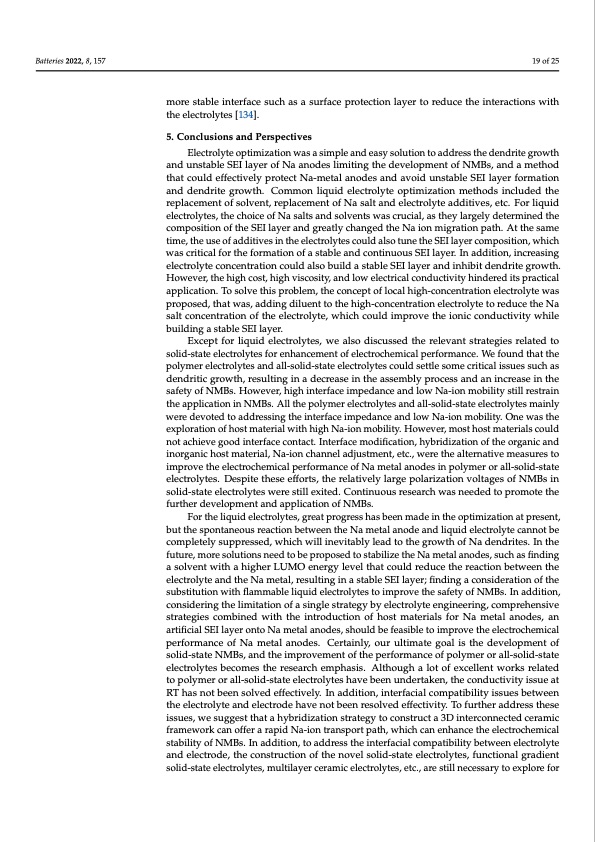
PDF Publication Title:
Text from PDF Page: 019
Batteries 2022, 8, 157 19 of 25 more stable interface such as a surface protection layer to reduce the interactions with the electrolytes [134]. 5. Conclusions and Perspectives Electrolyte optimization was a simple and easy solution to address the dendrite growth and unstable SEI layer of Na anodes limiting the development of NMBs, and a method that could effectively protect Na-metal anodes and avoid unstable SEI layer formation and dendrite growth. Common liquid electrolyte optimization methods included the replacement of solvent, replacement of Na salt and electrolyte additives, etc. For liquid electrolytes, the choice of Na salts and solvents was crucial, as they largely determined the composition of the SEI layer and greatly changed the Na ion migration path. At the same time, the use of additives in the electrolytes could also tune the SEI layer composition, which was critical for the formation of a stable and continuous SEI layer. In addition, increasing electrolyte concentration could also build a stable SEI layer and inhibit dendrite growth. However, the high cost, high viscosity, and low electrical conductivity hindered its practical application. To solve this problem, the concept of local high-concentration electrolyte was proposed, that was, adding diluent to the high-concentration electrolyte to reduce the Na salt concentration of the electrolyte, which could improve the ionic conductivity while building a stable SEI layer. Except for liquid electrolytes, we also discussed the relevant strategies related to solid-state electrolytes for enhancement of electrochemical performance. We found that the polymer electrolytes and all-solid-state electrolytes could settle some critical issues such as dendritic growth, resulting in a decrease in the assembly process and an increase in the safety of NMBs. However, high interface impedance and low Na-ion mobility still restrain the application in NMBs. All the polymer electrolytes and all-solid-state electrolytes mainly were devoted to addressing the interface impedance and low Na-ion mobility. One was the exploration of host material with high Na-ion mobility. However, most host materials could not achieve good interface contact. Interface modification, hybridization of the organic and inorganic host material, Na-ion channel adjustment, etc., were the alternative measures to improve the electrochemical performance of Na metal anodes in polymer or all-solid-state electrolytes. Despite these efforts, the relatively large polarization voltages of NMBs in solid-state electrolytes were still exited. Continuous research was needed to promote the further development and application of NMBs. For the liquid electrolytes, great progress has been made in the optimization at present, but the spontaneous reaction between the Na metal anode and liquid electrolyte cannot be completely suppressed, which will inevitably lead to the growth of Na dendrites. In the future, more solutions need to be proposed to stabilize the Na metal anodes, such as finding a solvent with a higher LUMO energy level that could reduce the reaction between the electrolyte and the Na metal, resulting in a stable SEI layer; finding a consideration of the substitution with flammable liquid electrolytes to improve the safety of NMBs. In addition, considering the limitation of a single strategy by electrolyte engineering, comprehensive strategies combined with the introduction of host materials for Na metal anodes, an artificial SEI layer onto Na metal anodes, should be feasible to improve the electrochemical performance of Na metal anodes. Certainly, our ultimate goal is the development of solid-state NMBs, and the improvement of the performance of polymer or all-solid-state electrolytes becomes the research emphasis. Although a lot of excellent works related to polymer or all-solid-state electrolytes have been undertaken, the conductivity issue at RT has not been solved effectively. In addition, interfacial compatibility issues between the electrolyte and electrode have not been resolved effectivity. To further address these issues, we suggest that a hybridization strategy to construct a 3D interconnected ceramic framework can offer a rapid Na-ion transport path, which can enhance the electrochemical stability of NMBs. In addition, to address the interfacial compatibility between electrolyte and electrode, the construction of the novel solid-state electrolytes, functional gradient solid-state electrolytes, multilayer ceramic electrolytes, etc., are still necessary to explore forPDF Image | Recent Development for Sodium Metal Batteries

PDF Search Title:
Recent Development for Sodium Metal BatteriesOriginal File Name Searched:
batteries-08-00157-v2.pdfDIY PDF Search: Google It | Yahoo | Bing
Salgenx Redox Flow Battery Technology: Salt water flow battery technology with low cost and great energy density that can be used for power storage and thermal storage. Let us de-risk your production using our license. Our aqueous flow battery is less cost than Tesla Megapack and available faster. Redox flow battery. No membrane needed like with Vanadium, or Bromine. Salgenx flow battery
| CONTACT TEL: 608-238-6001 Email: greg@salgenx.com | RSS | AMP |